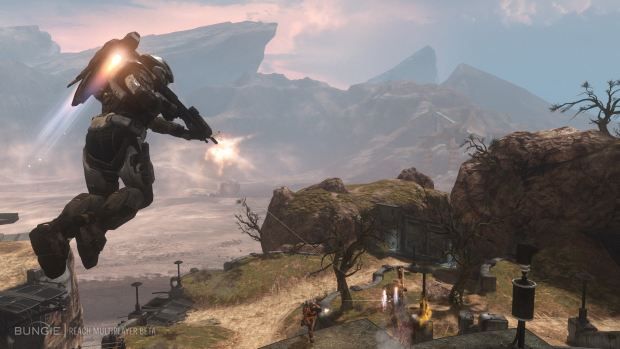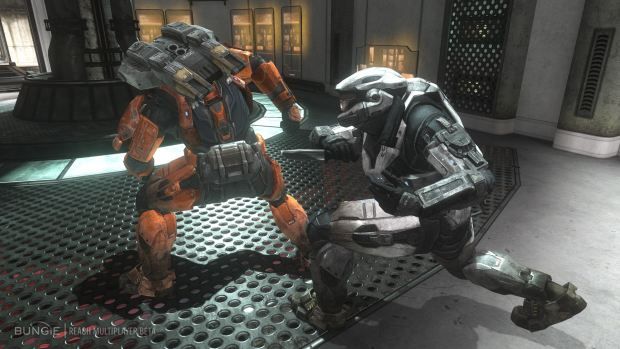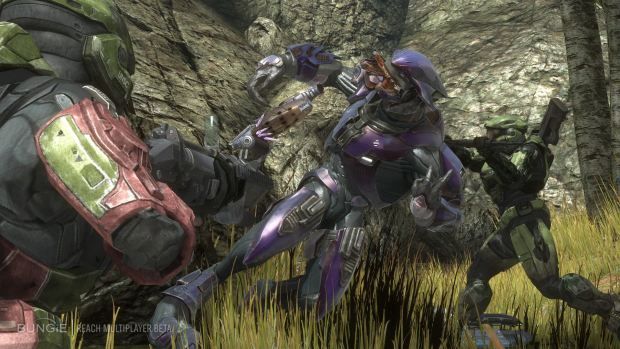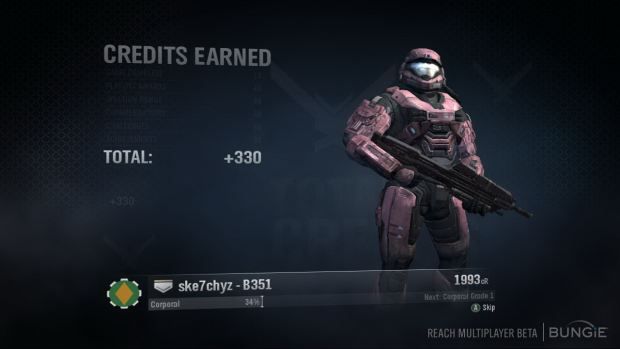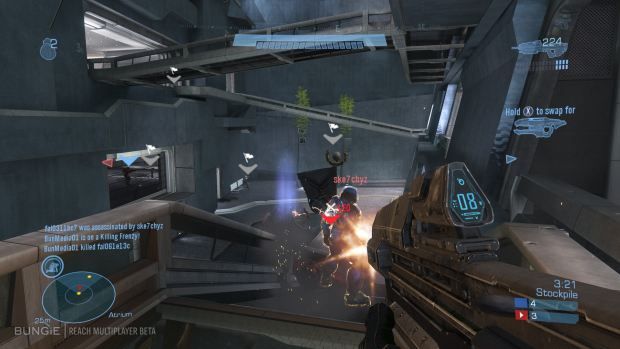Halo. It's yesterday's game, right? The teeming multitudes of online gamers have made Modern Warfare 2 the big online game of the moment, and those in the know are playing Battlefield: Bad Company 2 instead. Sure, Halo has a colossal fanbase, but let's face it: the tech is old and the gameplay a bit old-school by 2010 standards. Isn't it time that the old champ gracefully retired?
Our quick take
If you thought you were bored of Halo multiplayer, think again. Two hours with the Reach beta flew by, giving us some of the most enjoyable FPS action we've had in months. Sure, there are some issues with balance and UI - the objective markers aren't always as clear as they could be - but then these are exactly the things that a beta is supposed to sort out. Put it this way; the Reach beta feels more polished, more feature-packed and more entertaining than the Halo 3 beta did at this stage of the game - and we all know how well that turned out. In fact, it makes the multiplayer options of some recent full-price games feel miserly. If you liked Halo 3 enough to buy ODST, then you're in for a treat. If you didn't, perhaps it's time to reconsider. It might even be worth buying ODST on the cheap just to get your hands on this.
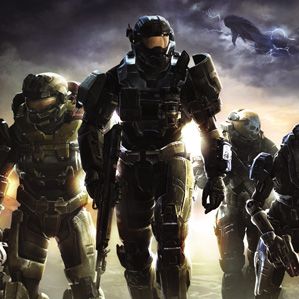
First Look
| FOR | AGAINST |
|---|---|
|
|
Not if our 2 hours with the Halo: Reach multiplayer beta is anything to go by. In fact, it looks more like Halo is staging an audacious comeback. With new modes, new maps, a new engine and a whole range of new features, Reach is fully-armed to slug it out with the latest stars of the FPS scene, and give Microsoft's flagship series a good shot at going back on top.
From what we saw in this week's press preview, the changes are many and varied, none of them spoiling or diluting the Halo experience, but loosening it, beefing it up and generally making it feel more epic and more fun. For a start, the beta introduces a new persistent experience system, with a system of in-game credits earned through good play and earning specific commendations. Credits not only count towards increases in rank, they also can be spent on upgrades in the brand new armoury. While these upgrades are purely cosmetic, it's easy to see the appeal. Nothing says you're the daddy clearer than a cool suit of custom armour, and the armoury already includes a cool collection of helmets, breastplates and decorations.
Classes - or load-outs in Bungie's terminology - are another major introduction to the game. Whether you play as a Spartan III (a precursor to Halo's Master Chief) or a Covenant Elite, you'll have a number of load-outs to choose from, with each one having its own starter weapons and a specific armour ability. Which load-outs are available will depend on the type of game and - in some cases - the stage of the game, but it's clear that while Halo hasn't gone down the "know your role" route of a Battlefield or Team Fortress 2, this is a subtle attempt to match equipment and abilities to certain styles of play.
Armour abilities are arguably the key enhancement for Halo: Reach. Basically, armour abilities are fixed, Crysis-style powers ranging from a high-speed sprint or a nice evasive roll to temporary invulnerability or a jetpack. You can trigger these with a quick press of the left bumper as long as you have energy to do so, with the gauge depleting fairly quickly and refilling over time.
The multiplayer beta also opens up a cluster of new game types. Headhunter is a free-for-all fragfest that has you gunning down foes to grab their skulls. The skulls then need to be deposited in a specially marked zone. The problem? If you get killed before you can deposit your collection, you've lost the lot. Stockpile, meanwhile, is described as "Capture the Flag on steroids". Each map is packed with neutral flags, and it's up to you to pick them up and take them back to your team base. There's more to it than that, however. Once you have your flag back at base you're obliged to defend it for a period, giving the opposing team the chance for a last minute steal. Both modes have a slight Quake 4/Unreal Tournament 3 feel about them, and while the new mechanics take a bit of getting used to (judging by one pitiful Stockpile match where neither team actually scored), they certainly show promise.
The other two new game types take Halo one step into Battlefield territory. The first, Generator Defence, has three Spartans defending three generators against three Covenant Elites. Sadly, this one wasn't available for play. Luckily the same didn't apply to the most exciting new game type: Invasion. It's a larger-scale, multi-objective affair, with two phases in which Spartans have to defend set objectives from destruction at the hands of Covenant Elites, followed by a frantic final phase where the Spartans have to prevent the Elites from taking a data core to a waiting getaway Phantom. The cool thing is that, the longer an Invasion goes on, the more crazed and excessive the action becomes. Better classes, bigger weapons and new armour abilities are opened up with each phase, and vehicles are eventually unleashed onto the battlefield. The final portion in particular is a hoot, with Scorpion tanks raining heavy fire down on the Covenant forces, while Wraiths scramble to intercept. It's uncontrolled carnage in all the best possible ways.
What's surprising is how well this all fits in with the Halo action we already know and love. The jetpack, for example, should have had irritating novelty pasted all over it, but instead it feels like it belongs. Soaring up into the air to grab a high position or take a rival by surprise works brilliantly, and it's easy to feather the jets if you want to control a heroic leap down towards the ground. The Sprint is a little ordinary and at the moment it's hard to imagine the invulnerability perk getting much love, but a stealth/camouflage ability opens up a number of tactical options - particularly if you're on the Covenant side in an Invasion match. Armour abilities aren't as extensive or all-pervasive a feature as the nanosuit abilities in Crysis Wars, but they certainly take Halo in a new and interesting direction.
We also got our hands on a few of the new weapons during the session. The new Designated Marksman Rifle, for example, will be a sure-fire hit with the less camping-prone sniper, offering a quick, long-range, single-shot scoped weapon that isn't completely useless at close quarters. Ditto the Needle Rifle, the Covenant's nearest equivalent. And what's not to love about a new variant of the classic Halo Plasma Rifle, or a hefty Spartan Grenade launcher which is a bag of fun in the chaos of a fraught Invasion battle?
Four new maps make up the scenery. Swordbase is a slightly dull ramp and corridor affair with a big central atrium, but it's good for close combat and has some nice sniping positions. Overlook, sadly, we didn't get to see. Boneyard is a dusty desert setting full of abandoned shipwrecks, custom-built for invasion, while Powerhouse offers the game's biggest visual treats, with circular buildings, rushing water and a touch more vegetation than the others. Add jetpacks to a Swordbase or Powerhouse-based game, and you'll soon get an idea of how well these maps have been designed with armour abilities in mind.
And this brings us neatly to the icing on the cake. Fans might not like to mention it, but Halo 3 is no longer one of the best-looking 360 shooters (if indeed it ever was); a fact that last year's ODST did little to conceal. With Reach, a brand new engine adds a new layer of grit and detail to Halo, making everything from the landscapes to the Spartan's armour and the Covenant's arsenal look more convincing. We also caught glimpses of some new cinematic grain and focus blur effects. We're not talking Killzone 2 or Crysis levels of visual lustre, but Reach should be able to compete with Modern Warfare 2 and Bad Company 2 on the visuals front. Also bear in mind that we're far from seeing the finished game in all its glory. The full game isn't due for release until September. The multiplayer beta, however, will be available from 6 May to anyone with a copy of Halo 3: ODST.
To recap
If you liked Halo 3 enough to buy ODST, then you're in for a treat. If you didn't, perhaps it's time to reconsider. It might even be worth buying ODST on the cheap just to get your hands on this

